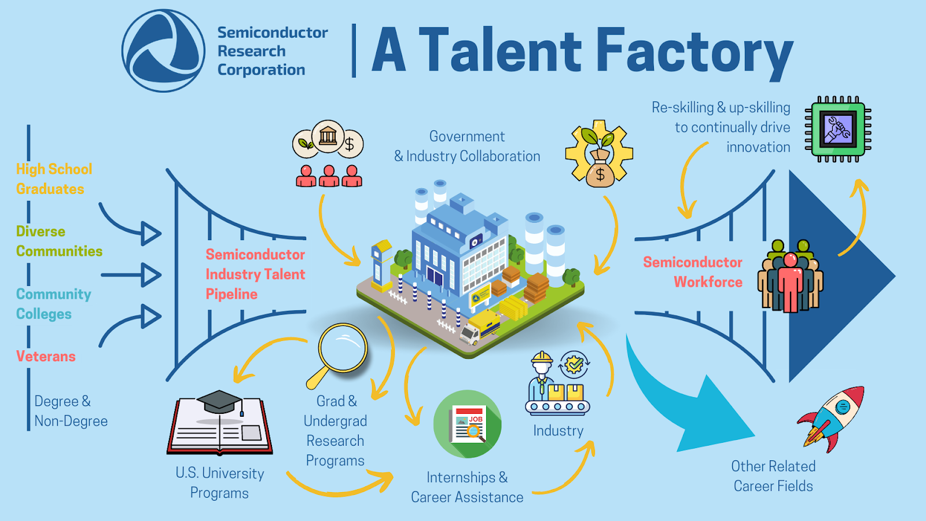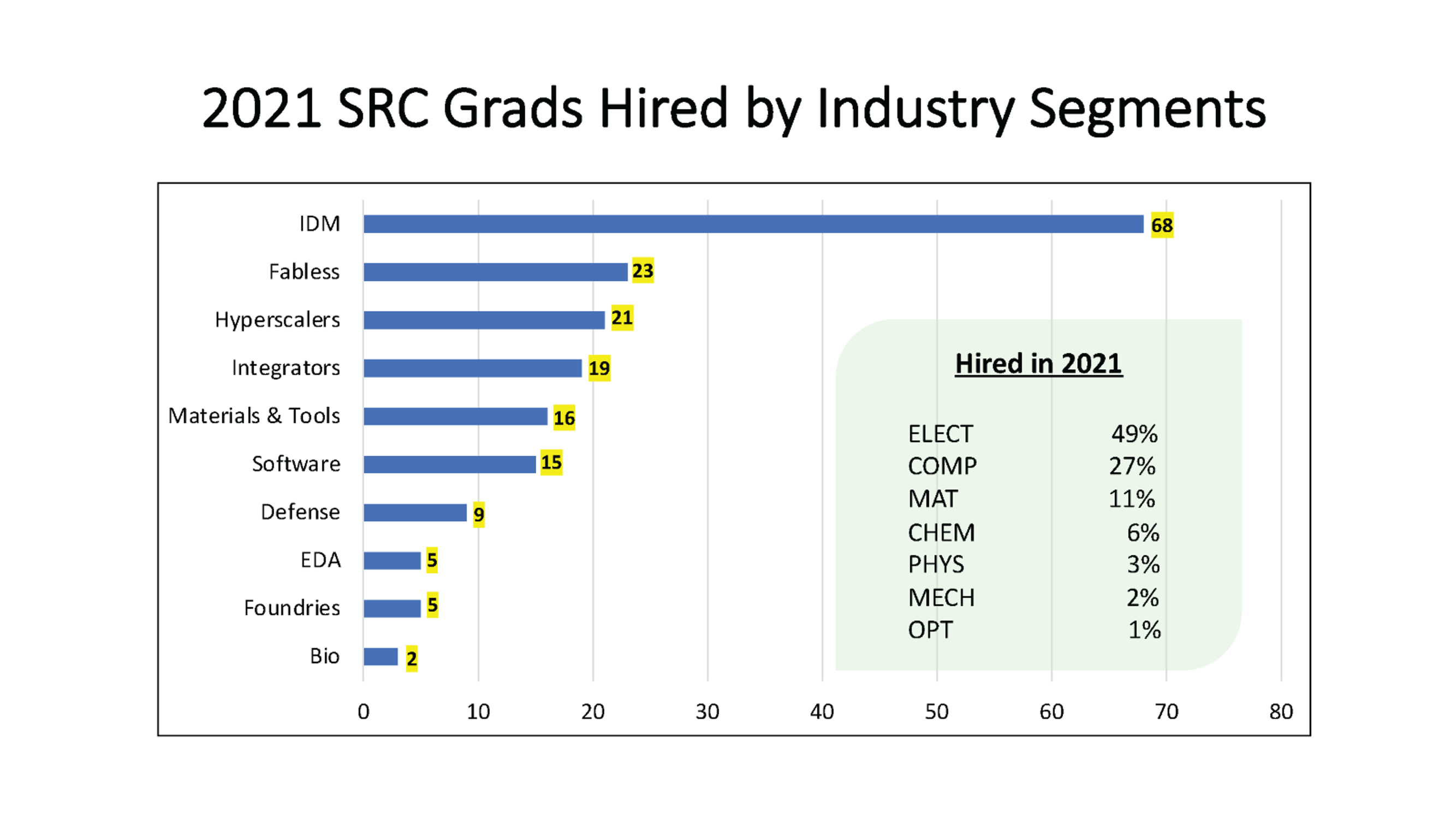Blog 2: A Talent Factory: The SRC Story

Workforce Development Blog
A Talent Factory: The SRC Story
Forging Ahead: Aligning Semiconductor Knowledge, Skills and Abilities
Shaping Tomorrow's Innovators: Strategies for Engaging STEAM Students in the Semiconductor Industry
Entering the Semiconductor Industry: Fulfillment Beyond a Paycheck
Summary of blogs and where do we go from here?
A Talent Factory: The SRC Story
Key points of Blog 2:
- SRC is a scalable ‘Talent Factory’ that even today supplies nearly 20% of the semiconductor PhD workforce nationwide, and there are mechanisms in place to increase the output manyfold as the demand grows.
- With additional funding, SRC can increase the number of supported students by 3-5x or more without any decrease in merit or industrial relevance.
- SRC supplies hundreds of well-trained graduates to equipment and material suppliers, semiconductor fabs, foundries, and fabless design and chip makers.
- More detailed data analysis is underway to support quantitative supply/demand modeling of the workforce development (WFD) needs for the Microelectronic and Advanced Packaging Technologies (MAPT) Roadmap https://srcmapt.org/
In our previous blog post, we revealed that 56% of individuals employed in the semiconductor industry possess a bachelor's or graduate degree. The industry relies heavily on a pool of STEM talent, which includes both degree-holders and skilled workers. However, due to the existing workforce talent shortfall and its projected increasing deficit, relying solely on universities may not be sufficient. As a solution, other scalable talent mechanisms will be necessary in the coming years. Thanks to its collaborative approach, including partnerships with DARPA, NSF, NIST and Industry, Semiconductor Research Corporation’s (SRC) programs have been successful in preparing a significant proportion (approximately 20%) of semiconductorPhD candidates in the United States.
SRC is a special entity created by the semiconductor industry to meet its ever-growing needs for planning and execution of research and workforce development. Serving as a “Talent Factory,” SRC supplies hundreds of well-trained graduates each year to equipment and material suppliers, semiconductor fabs, foundries, and fabless design and chip makers. To accomplish this, SRC distributes industry investments to universities to ensure that industry-relevant research and education are properly funded. SRC then facilitates students’ involvement in SRC-funded projects and aids in the interface between students and industry in terms of internships and hires.

SRC's Talent Factory is committed to developing talent within the semiconductor pipeline, with a particular emphasis on individuals pursuing higher education degrees. In line with this commitment, SRC has pledged to broaden participation by 2030. Over the next decade, SRC will focus on expanding its student base, developing a diverse and inclusive community, and establishing a balanced mix of bachelor's, master's, and PhD-level initiatives. As SRC defines, selects, and manages its research and education programs, it will prioritize these objectives to foster a thriving talent ecosystem.
SRC aims to broaden its reach in the future by potentially forming partnerships with community colleges and diverse communities hoping to encourage individuals to pursue a career in microelectronics. While the primary focus of SRC is on expanding the degree talent pipeline, we recognize that non-degreed talent is also critical to the semiconductor pipeline—these skilled laborers comprise a significant portion of it. In upcoming blogs, we will delve into this topic further.
What’s in SRC’s Secret Sauce?
SRC offers research contracts to support academic research, and Research Scholars programs for undergraduates and graduates who are interested in the semiconductor and microelectronics fields. These contracts provide funding and resources to universities and their faculty members to conduct research in specific areas of interest to industry partners,as well as opportunities for collaboration, education, and networking.
SRC’scollaborative approach offers valuable opportunities for students to gain practical research experience, access to industry professionals, and exposure to revolutionary technologies. The multi-disciplinary and goal-driven approach used in SRC programs provides education that enriches and prepares students in ways that traditional degree programs do not.
In addition, various educational opportunities are offered in the form of eWorkshops, industry webinars, and talks at annual research reviews. Our member resources catalog contains a wealth of information provided by SRC members for the academic community and includes education, design, and prototyping. We encourage SRC researchers and students to utilize these resources to enhance their research and educational endeavors.
Over the past 40 years, SRC has supported over 15,000 students. These students, or, rather, “SRC Research Scholars,” benefit in several ways, including:
-
Students and faculty members can connect with industry professionals, gain industry insights, and develop valuable networking opportunities and perspectives.
-
Students can gain hands-on experience in semiconductor-related research, which can help them in their academic and professional careers. This is especially critical for undergraduates and increasing the volume of the workforce pipeline.
-
SRC's research contracts focus on cutting-edge technologies, which provide students and faculty members with exposure to the latest advancements in the semiconductor industry.
-
SRC Research Scholars programs and research contracts provide financial support to students and faculty members, which can help them fund their education and research projects.
-
SRC Research Scholars programs and research contracts provide mentorship from industry professionals, which can help students develop their skills and knowledge in the semiconductor industry. Establishing direct connections with industry can also open the door for full-time jobs and internship opportunities.
SRC's industry-led boards have attested that we can increase the number of students we support by 5x or more without any decrease in merit or industrial relevance. Allocating more funding for research will in turn be beneficial in supporting more students interested in studying microelectronics, which would help to retain talent in the industry and support tech innovation in the U.S. Currently, only around 5% of the ideas SRC receives can be funded due to limited funding resources.
It is alarming to learn that students who are interested in studying semiconductors but cannot access funding will eventually decide to pursue other scientific and engineering vectors, such as medicine, biotech, and energy. This trend could result in the U.S. losing semiconductor-related talent, which would be detrimental to the semiconductor industry and tech innovation.
The Proof is in the Pudding
Many may be surprised to know SRC was involved in preparing nearly 20% of all semiconductor-related PhD degrees in 2021, and this level of support is scalable.

There are about 1500 students active in SRC programs at any one time. In 2021, there were 279 SRC graduates: 78 BS, 29 MS, and 172 PhD graduates in semiconductor disciplines.
Where are those 279 semiconductor students today? The majority (198, or 71%) joined different segments of industry. By degree, 46% of bachelor’s, 97% of master’s and 78% of PhDs have chosen careers with industry. The distribution of 2021 SRC graduates among different segments of the semiconductor and the IT ecosystem is shown in the Figure above. An inset shows the distribution of industry hires by discipline. (See glossary below for definition of table terms.)
Show me the numbers!
Let’s put the SRC numbers in the context of the nation-wide data collected by the American Society for Engineering Education (ASEE). The total number of EE and ECE PhDgraduates in 2021 was 2,423 (Engineering & Engineering Technology by the Numbers (2021)). How many of them are ‘semiconductor microelectronics’ graduates? A reasonable assumption is that the fraction of ‘semiconductor microelectronics’ PhD candidates across all EE and ECE specializations is related to the fraction of faculty with semiconductor research profiles. For example, at North Carolina State University ECE department, approximately 20% of faculty are involved in research related to semiconductor microelectronics, therefore representing 20% of ‘semiconductor’ PhDs (source: Dr. Victor Zhirnov). By the same scale, we can calculate that 485 were semiconductor EE/ECE PhD graduates in 2021, nationwide. As a first-order estimate, 172 of the PhD graduates from SRC’s Talent Factory represent approximately 35% of the total.
First, by looking at the figure above, we can see that the EE/ECE disciplines constitute close to 50% of all industry placements of SRC graduates. Therefore, we can deduce that SRC supplies no less than 17% of semiconductor PhD workforce nationwide. Secondly, this analysis needs to be expanded to other disciplines, such as Computer Science, Materials and Chemical Engineering, Physics, etc. Then, a more representative sampling of U.S. universities will allow for even more precise calculations. Finally, this analysis needs to be expanded to include bachelor’s and master's degrees. These are the topics of ongoing studies that SRC is conducting to form an accurate picture of semiconductor graduates entering the workforce. The results will be published in subsequent blogs and used for quantitative supply/demand modeling of the WFD needs for the Microelectronic and Advanced Packaging Technologies (MAPT) Roadmap.
In summary, while SRC is a collaborative organization providing funding and member resources to universities focused on industry-relevant research, SRC also serves as a robust and scalable Talent Factory for the U.S. semiconductor industry. Currently, SRC supplies nearly 20% of the semiconductor PhD workforce in the U.S. and has the capability to increase output by 3-5 times to meet growing demand. By funding more students interested in studying microelectronics while broadening participation, SRC's Talent Factory can retain talent in the industry and drive the next wave of technological innovation in the United States.
Have a comment or a question for us? Send it HERE.
| Glossary of Terms for Table 1 | |
|---|---|
| IDM (Integrated Device Manufacturer) | a semiconductor company which designs, manufactures, and sells integrated circuit (IC) products. Examples of IDMs are Intel, Samsung, and Texas Instruments. |
| Fabless (Fabless Semiconductor Company) | which outsources production to a third-party semiconductor fabrication plant. Examples of fabless companies are AMD, MediaTek, and Qualcomm. |
| Hyperscalers | companies like Google, Meta, Amazon etc. that both dominate in the cloud service domain and to expand their business into numerous related verticals. |
| Integrators | consumer-facing Technology Companies. Examples include Apple, Bosch, Tesla. |
| Materials and Tools | a category of companies that supply equipment, tools and materials for semiconductor manufacturing. Examples include Applied Materials, Tokyo Electron, EMD Electronics. |
| Software | software companies of various profiles. Examples are Oracle, Intuit, Snowflake. |
| EDA (Electronic Design Automation) | Examples of EDA companies are Siemens EDA, Synopsys and Cadence Design Systems. |
| Defense | defense technology companies, such as Raytheon, Northrop Grumman, Draper Laboratory. |
| Foundries | semiconductor companies providing specialized foundry services, such as GlobalFoundries, TSMC, Tower Semiconductor. |
| Bio | biotechnology/biomedical companies. Examples are Illumina and Smith & Nephew. |


